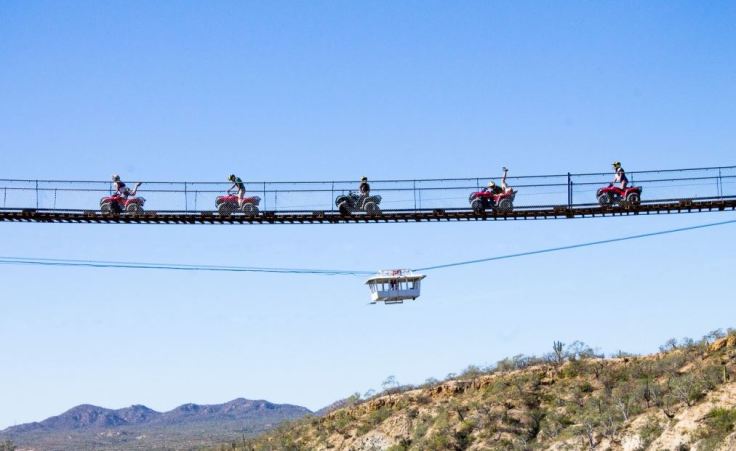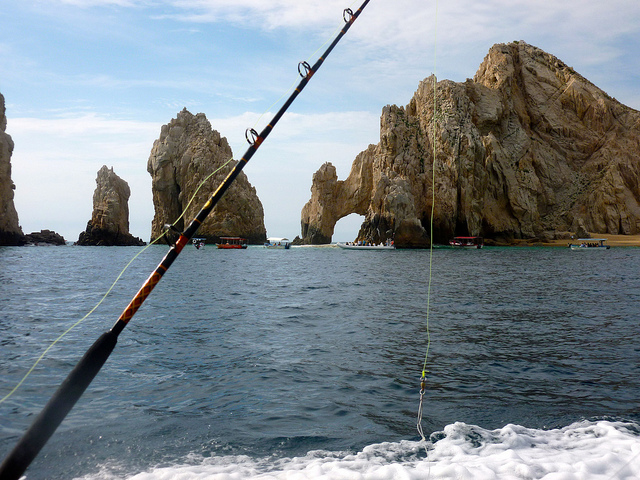ATV In Cabo
Los Cabos Canyon Bridge is the longest wooden pedestrian and ATV hanging bridge in the world! It is not only a landmark of Los Cabos and the Baja California state; it can be called without doubt an engineering wonder.
The Cabos Canyon Bridge is 1,082.67 feet long, 6.56 feet wide and it stands at 164.04 feet above ground in its lowest point. We made it in about two years with Mexican technology exclusively developed in collaboration with MAM Geotecnia (Mexicana de Anclas Mineras) and Best Engineering Firm but the construction itself was made in a time record of four weeks! Its #5, 2″ Swedish steel cables can make The Cabos Canyon Bridge able to hold up to 300 persons or 50 ATV’s simultaneously.

Land a Marlin

Cabo is called the marlin capital of the world. If you want to find out whether that’s a gimmicky line or if it’s true, plenty of captains are standing by to take you on a sport-fishing excursion.
Drop your line in the shadow of the famous arch of Cabo or ask your guide to take you to a lesser-known spot where the fishing’s good.
Sport-fishing boats for charter range from 24 feet to more than 40, and trip options run from half-day to full-day or multi-day excursions.
Stand up and Paddle

The Pacific waters of San Jose del Cabo are perfect for all sorts of water sports and recreational activities, including the increasingly popular stand-up paddleboarding.
Know Before You Go
When to Go
Los Cabos is that rare destination where the weather is nearly perfect year-round; in any given year, the area averages 350 days of sun. In summer months, temperatures top out at 90 degrees; in the winter, it’s a near-constant and comfortable 77. The caveat emptor here, though, is hurricane season. Travelers considering a vacation in Los Cabos might want to schedule it outside June to early November, when tropical storms and hurricanes can kick up quickly. In September 2014, Los Cabos was slammed by category 4 Hurricane Odile, the most devastating hurricane to hit the area since the 1960s. Many structures in Los Cabos were damaged, including the airport, which was closed for nearly a month. Most major hotels were scheduled to remain closed for repairs until the first quarter of 2015. On the other hand, because these months are also “low season,” hotels can offer rate discounts of as much as 25 percent.
Getting There
Most travelers arrive in Los Cabos via plane, and the two towns share an airport, Los Cabos (SJD). The airport is approximately six miles from the town of San José del Cabo. U.S. airlines that provide service to SJD include American, Delta, Frontier, Southwest, Spirit, United, and US Airways. Alaska Airlines and Canada’s WestJet also make flights, and Aeromexico services some U.S. cities, including Atlanta, from Los Cabos. Not all carriers offer direct flights, though, so check for layover information. The airport is on the small side, but it’s in the process of expanding to accommodate more international flights. Travelers from the U.S. are required to present a valid passport upon arrival. When clearing immigration, they’re given a tourist card, which must be kept inside the passport and presented to immigration officials when departing the country.
Getting Around
Taxis, shuttles, and rental car services can all be hired at the airport; a rental car is recommended for visitors wanting to explore the lower Baja California peninsula. Highways and primary roads throughout the area tend to be well maintained; secondary roads can be bumpy and a bit wild, often with poor signage. The main highway through the region is the Carretera Transpeninsular, which runs all the way from Tijuana to the southernmost tip of the Baja California Peninsula, more than 1,000 miles in all. Many hotels and attractions are located along or just off the carretera, and addresses are indicated by the kilometer number on the highway (e.g., Km 19 Carretera Transpeninsular).
Food & Drink
Los Cabos is a bit unusual compared with the rest of Mexico, where each state has a distinct traditional regional cuisine. Here, there’s not necessarily a single defining dish (unless you count the Baja fish taco), and many restaurants can be a bit too touristy for travelers in search of authentic Mexican meals. That being said, Los Cabos’ coastal position means that fish and seafood are as fresh as they come, and many restaurants here specialize in grilled catch of the day. Guests can even bring their own fresh catch for the chef to prepare to their taste. The Baja California peninsula also has a growing farm-to-table movement, and many restaurants tout their locally-sourced produce, which includes chilies, tomatoes, and herbs. Baja California is also Mexico’s principal grape-growing and wine-making region, and guests love sampling the local wines, which are very difficult to find in the U.S. due to low production levels.
Festivals and Cultural Highlights
As with food, Los Cabos isn’t known for its traditional festivals or cultural activities; much of the area was purpose-built for tourists and expats, so strong cultural traditions don’t have the same kind of rootedness here that they have in most other areas of Mexico. That doesn’t mean that the area is devoid of culture, however. Popular annual events include the Los Cabos International Film Festival and the Los Cabos Open of Surf, an international surfing competition, as well as the food and wine festival hosted by the Resort at Pedregal (formerly Capella Pedregal).
What the Locals Know
Credit and debit cards are accepted widely, but cash remains king, so it’s best to keep a bit on hand, preferably in smaller bills, as many vendors can’t or won’t make change for large bills (50 and 20 peso notes are ideal). If using a credit or debit card, notify your bank or card company prior to traveling; they will put a “travel alert” on your card, preventing it from being flagged for fraud.
Day Trips
Los Cabos may seem geographically isolated at the southernmost point of the Baja California peninsula, but it’s an ideal jumping-off point for a number of day trips, both on land and by sea. The towns of Todos Santos and La Paz are popular destinations, reachable by car. Similar to Los Cabos in geography, their vibe is more laid-back and New Age artsy. By sea, charter and outfitter companies can put together a wide variety of excursions, from deep-sea fishing and diving packages to whale-watching trips. Hotel concierges can typically assist with providing information about day trip options, as well as recommended local outfitters who serve as excursion guides.
Local’s Pick—One Thing to Do
Flora Farm isn’t a best-kept secret anymore, but this organic farm and field-to-table restaurant remains off the beaten track—literally—and draws those in the know for a delicious dining experience. Guests can see where their food comes from, and chefs can make a quick run to the field if they need to make a last-minute addition to a dish. Seasonal cocktails are “garden to glass”; drinks such as the “Farmarita” feature heirloom vegetables from the farm’s own fields. Reservations are a must.




Leave a comment